Site menu:
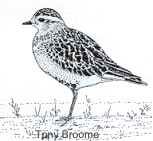
June 2015 Newsletter
Liverpool Bay Common Terns.
Gronant Little Terns - Appeal for Wardens.
Colour Ring Report.
May Bird News.
Forthcoming Events.
Latest Newsletter.
Liverpool Bay Common Terns
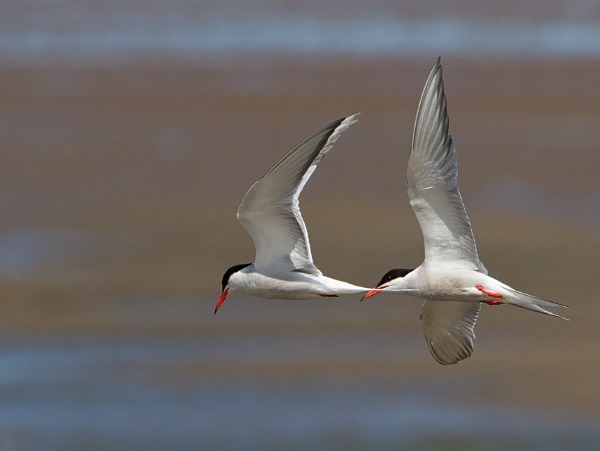
For those of us on the Dee Estuary who love Common Terns, and there
can't be many who don't, the past six years have been a worrying
time. At Shotton Lagoons we
had one of the biggest Common Tern colonies in the country where in
2008 750 pairs produced over 1,000 fledged young, a productivity of 1.3
which in itself is a high number (productivity is the average number of
fledged young per breeding pair). In 2009 the terns returned as normal
but then
deserted the colony after just a week with the same thing happening in
2010,
2011 and 2012. Investigations strongly suggested that the main reason
for the colony's collapse was a major reduction in fish stocks.
Thankfully the fish stocks recovered in 2013 and many pairs did return
to breed with over 400 birds counted, but unfortunately fox predation
meant just two chicks fledged that
year. To try to stop the foxes and other land predators fences
were erected around the nesting islands the following winter and this
had
the desired effect as in 2014 c225 pairs successfully fledged 445
young, an excellent productivity of 1.98 - compare that with the
typical national productivity of 0.5. John Elliott of the Merseyside Ringing Group
(the organisation who built up the Shotton colony from scratch
and manage the reserve) has written an excellent article
detailing both the history of the Shotton Lagoons reserve and the
actions taken since 2009 and you can read it by downloading 'River
Dee Common Terns - Triumph or Disaster?', when
downloaded scroll to page four (also see Species
Spotlight - Common Tern, in the May 2004 Dee
Estuary Newsletter).
Lets hope the colony now returns to
normal and we can be sure the Merseyside Ringing Group will do their
utmost to bring this about. The good news for 2015 is that by
the third week in May over 200 birds had returned to the Shotton Colony
and courtship displays, birds carrying fish etc were all in evidence -
so it looks promising.
The Shotton colony is part of the Liverpool Bay meta-population, in 2008 the main colonies within this population were at Shotton (750 pairs), Seaforth (136 pairs in 2008, 181 pairs in 2007) and South Ribble Marshes (111 pairs). Seaforth has always been something of a 'second home' for Shotton terns (there have been almost 2,000 ring recoveries of Shotton birds at Seaforth) with large numbers present post-breeding, including juveniles, and it was here they decamped to in 2009. Unfortunately the sudden influx of birds which occurred on May 25th, from 350 to 1,250, caused utter mayhem with severe overcrowding on rafts which had room for only 200 pairs. Many eggs were lost and only an estimated 30 young fledged in 2009 with similar problems the following two years.
But in 2010 a development occurred with the establishment of a new colony in Langstone Dock (part of Liverpool Docks) where it was thought 125 pairs raised a good number of young with perhaps as many as two fledged per pair - it is very likely that these were Shotton birds. 2011 saw 300 nests at Langstone Dock but they deserted in July probably due to fox predation and in 2012 this site was no longer available but they may have bred elsewhere in the docks. Meanwhile, another new colony appeared at Preston Docks with just two pairs in 2009 increasing to 120 pairs by 2013. It seems that at least some of the birds breeding here came from Shotton as seven had been ringed as chicks there.
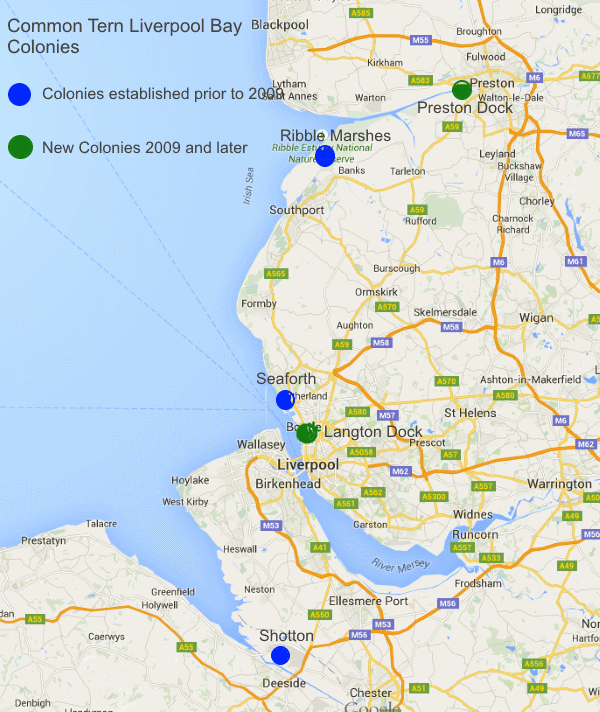
So the problems at Shotton have had big knock-on effects within the Liverpool Bay area with chaos at Seaforth but also the establishment of one new successful colony at Preston and another one in Liverpool Docks which was successful for at least one year and they may still be breeding within the area. Overall both breeding pairs and productivity in the meta-population is still well down on 2008 but with the partial reestablishment of the Shotton colony in 2014 things are looking far more hopeful.
When and where to see Common Terns on the Dee Estuary.
The area which includes Formby Beach, Seaforth, North Wirral and the mouth of the Dee estuary is one of the most important post-breeding staging areas in the country with total numbers peaking around the 2,000 to 3,000 mark in August. These will be mostly from the Liverpool Bay meta-population and will include both breeding and non-breeding sub-adult birds as well as the current year's juveniles. We also know from ringing recoveries that birds fly overland to Liverpool Bay from the north-east of England where there is an important staging area at Teesmouth, and others may well come from as far away as Scandinavia. What we don't know is what the turnover of birds is and this might be quite high so we could well be seeing a total of well over 5,000 birds passing through between late July and into September. Many of these may well make their way to Dublin Bay where the staging site there typically holds at least 8,000 terns - the largest gathering in the British Isles.
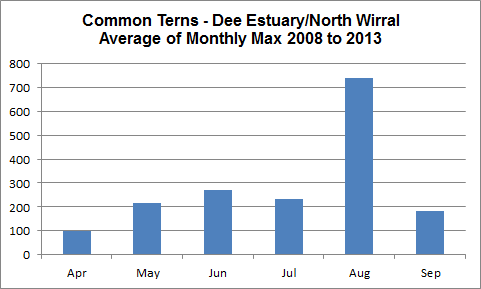
of records come from Point of Ayr, Hilbre, West Kirby and Hoylake.
The best places to see these large
August flocks are off Hilbre at low tide
and at Point of Ayr, West Kirby and Hoylake shore at high tide -
although a medium high tide is best when there is plenty of sand left
to roost on. They are often mixed in with larger numbers of Sandwich
Terns but sometimes they can end up flocking together in roosts several
hundred strong. I find it interesting to count the adult to juvenile
ratio to estimate how good a breeding season it has been.
Outside the post-breeding period Common Terns start passing through here on spring migration from mid-April to mid-May. By the middle of May many will be returning to their breeding colonies and we can see these feeding through the breeding season from Connah's Quay to Point of Ayr for the Shotton colony and from the River Mersey mouth at New Brighton to Hilbre for the Seaforth colony. By September the autumn migration will be well underway and it is interesting to speculate from how far north the birds we see then have come from with the large numbers breeding in Scotland and Scandinavia on their way south.
Sources of Information for this article.
Merseyside Ringing Group
1. David Norman, Investigations into the Failure of the Shotton Common Tern Colony (notes from meeting Aug 2010).
2. David Norman, Continuing Investigation into the Failure of the Shotton Common Tern Colony, 2009-2012, (notes from meeting Feb 2012).3. Peter Coffey, Common Terns in the Dee Estuary, May-July 2013, Merseyside Ringing Group Annual Report 2013.
4. Peter Coffey, Common Terns at Shotton, Dee Estuary Conservation Group (from minutes of meeting Oct 2014).
5. John Elliott, River Dee Common Terns - Triumph or Disaster, Wirral Wildlife Spring 2015 Newsletter.
6. Peter Coffey, pers. comm., May 25th 2015.
Other sources:1. Steve White, Shotton Common Terns at Seaforth and Liverpool Docks, Lancs Wildlife Trust, Aug 2010.
2. Lancashire Bird Reports 2001 to 2013.
3. Hilbre Bird Observatory.
4. David Cabot & Ian Nisbet, Terns, New Naturalist Library, Collins, 2013.
5. Cheshire and Wirral Bird Reports 2001 to 2013, CAWOS.
6. Cheshire and Wirral Ornithological Society Database covering years 2008 to 2013.
7. Dee Estuary Birding Website deeestuary.co.uk, and everyone who has sent in Common Tern counts.8. Robin M. Ward (2000): Migration patterns and moult of Common Terns and Sandwich Terns using Teesmouth in late summer, Ringing & Migration, 20:1, 19-28.
9. JNCC, Latest population trends - Common Tern, August 2014.
10. Wetland Bird Survey, BTO - on-line data http://blx1.bto.org/webs-reporting/.
Richard Smith
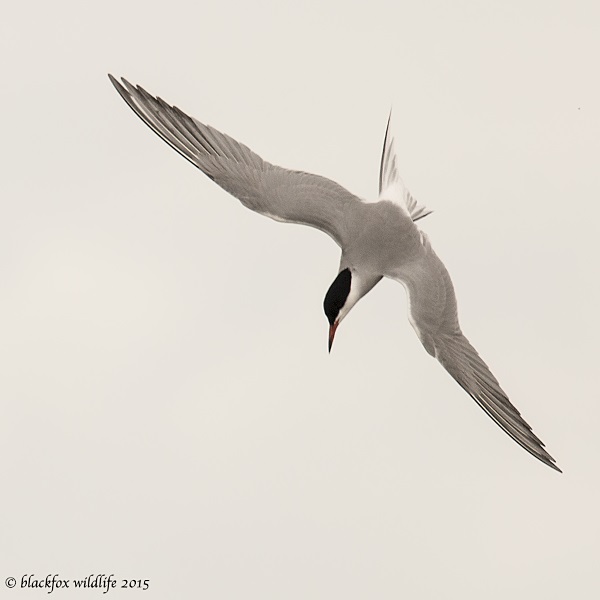
Top of Page
Gronant Little Terns - Appeal for Voluntary Wardens
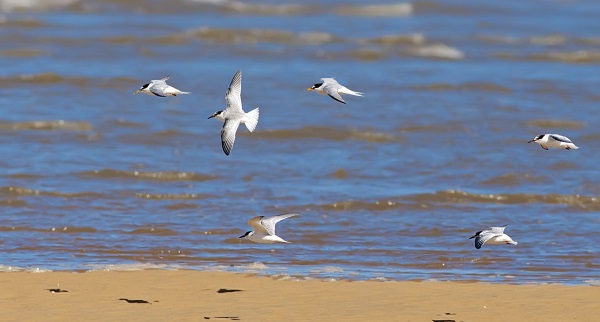
2015 marks 50 years of protection for the Little Tern colony, and since
1975 the number of pairs have increased from 15 to 136 - a huge success
for this Amber Listed species. There's no doubt that without the
wardening scheme, and the huge amount of time and effort by the RSPB up
to 2004 and Denbighshire Countryside Service over the past 10 years,
this colony wouldn't exist. We are again appealing for volunteers for
the 2015 season. Email gronantlittleterns@gmail.com
or ring Denbighshire Countrside Service on 01745 356197, or
just
come along to the colony and introduce yourself. See also the Gronant Site
Guide and the 2009
Newsletter
gives some guidelines as to what the job of voluntary warden involves.
Whether wardening or not this is a wonderful place to spend a few hours
great birdwatching.
In addition there is much information
on social media - see
https://www.facebook.com/gronantlittleterns.
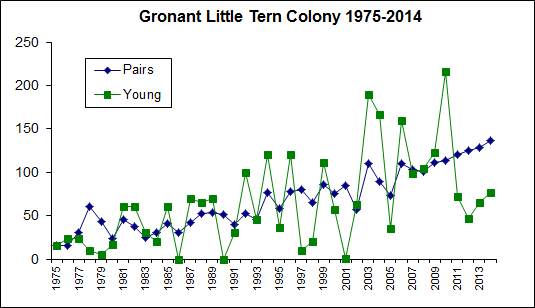
Postscript: I recently found out about
a Little Tern ringed as a chick at Gronant on June 26th 1994 and found
dead there on May 29th 2013 - this is 18 years 11 months and 3 days
after it was ringed which at the time was the new BTO-ringed longevity
record-holder. Since then an older bird was found in Norfolk in 2014.
There have been even longer records with a German one of almost 24
years and a Danish one of just over 23 years.
Top
of Page
Colour Ring Report
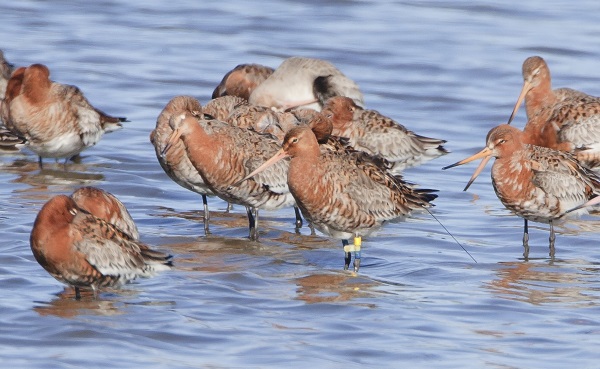
Photo of 'Tirns' above by Matt Thomas - see http://www.fromthemuddybanksofthedee.com/
Although the numbers involved were low this year for the Black-tailed Godwit spring migration we did see some interesting ringed birds including the above which is satellite tagged (you can see the aerial sticking out the back). This was ringed and tagged in Spain by the grutto volprogramma project, the bird has been named 'Tirns' by the ringers (Tirns is a small village in Holland where the continental race of Black-tailed Godwits breed). This is only the second Icelandic Black-tailed Godwit that has ever been sattelite tagged - the other being called 'Rotterdam' which we saw on the Dee Estuary in autumn 2013 (see the Rotterdam on the Dee Estuary article).
A brief summary of 'Tirns's' life history since it was ringed and tagged:Ringed and tagged in Extemadurea, SW
Spain, in February 2014.
Spring
2014 - flew south to Cota Donana before flying first to Brittany then a
brief three day visit to south Wales, Somerset and Sussex. Presumably
it was an immature bird as it didn't fly to Iceland to breed,
Summer 2014 - Spent the summer in Brittany before flying to southern
Spain in mid-August.
Autumn 2014 - Southern Spain.
Winter 2014/15 - Southern Spain.
Spring
2015 - Brittany until April 10th when it flew to south Wales. Reached
Gilroy Nature Park, West Kirby, on April 24th and remained in our area
until April 29th taking the opportunity to visit both the Dee and
Mersey estuaries. It reached Northern Ireland on May 2nd where it
stayed around Belfast Harbour until May 21st when it was in Coll in the
Inner Hebrides and in North Uist on May 25th.
May 28th - Tirns finally arrives back in Iceland, probably for the
first time since it was a chick.
Photo of 'Tirns' above by Matt Thomas - see http://www.fromthemuddybanksofthedee.com/
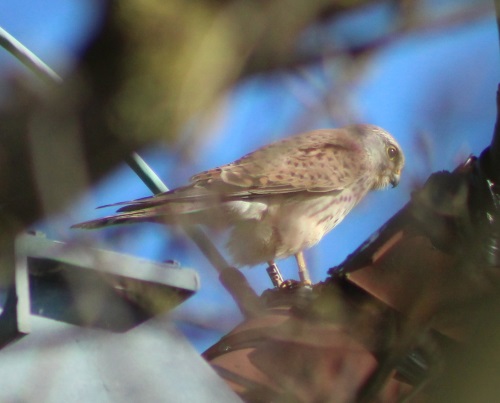
We don't often see colour-ringed raptors so we were particularly pleased when Elliot Monteith sent us this photograph of a Kestrel at Burton Mere Wetlands with alpha-numeric 7B on a brown ring. It was ringed as part of a project to monitor the dispersal of young Kestrels in Wirral:
Ringed: Brimstage June 1st 2014.
Observed: Burton Mere Wetlands March 14th 2015.
Colour-ringed birds were also recorded by John Jakeman, Manu Santa-Cruz, Chris Tynan and Elliot Monteith.
Top of Page
May Bird News
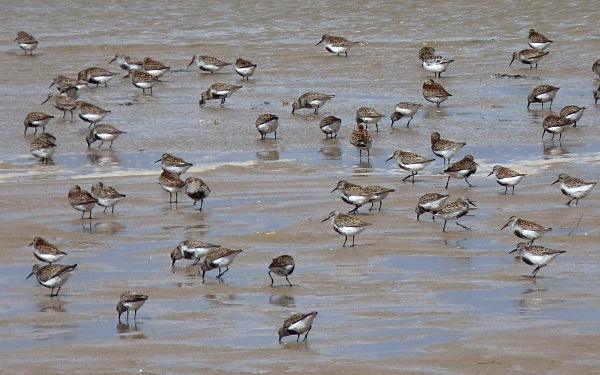
Dunlin numbers on spring passage seemed to have increased significantly over the past few years and this May we had just over 10,000 at both Hoylake (8th) and Hilbre (13th), with high counts throughout the month. These birds show a good range of sizes as well as other characteristics such as bill length and how well defined the belly patch is - and this demonstrates that these spring migrants comprise of several different races. But things are somewhat complex and I quote from the Leasowe Blog: "The taxonomic position of these races is at present in a state of massive flux with recent studies indicating the racial composition is not what it was previously thought to be". These birds are currently being extensively studied by local birders Jane Turner and Mark Turner and will be the subject of what will be a fascinating article in a future Newsletter.
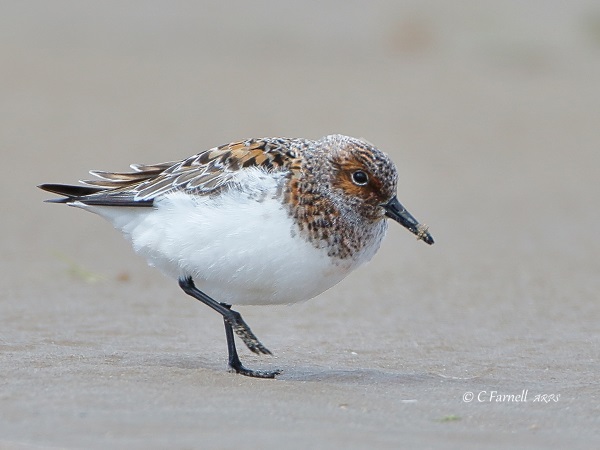
Numbers of Sanderling reached a max of 350 at Hoylake on the 18th, they always look a bit strange in their summer plumage (above) after being used to their very pale non-breeding plumage for the rest of the year. With the Dunlin flock were three Dotterels looking great in their breeding plumage. Over May and early April we've had a total of nine records of Curlew Sandpipers which is well above average, these records probably involved at least five different birds; many springs we don't get any at all. Whimbrels were also passing through and as usual Heswall had the largest count with 42 on the 7th.
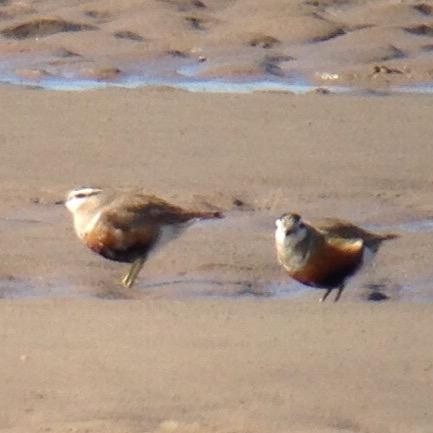
Looking back it seems like we had cold west and north-west winds all month! At least we had a few good days sea-watching which included 103 Manx Shearwaters on the 12th and five Great Skuas and 250 Gannets past Hilbre on the 19th.
Despite the winds we did have some nice migrants with peak numbers all being seen in the Leasowe Lighthouse area: 13+ Whinchats on the 1st, 13 Yellow Wagtails on the 5th and nine Spotted Flycatchers on the 11th, plenty of Wheatears too. Also at Leasowe was a Turtle Dove which stayed for a couple of days, a rare bird these days.
There were Garganeys at Burton Mere Wetlands most of the month including a pair on the 17th and two drakes on the 25th, also a Little Gull gave good views there for a week from the 17th. Eight Eiders were off Hilbre on the 21st. Single Ospreys were at both Hilbre and Burton Mere Wetlands at the end of the month - perhaps a wondering non-breeder?
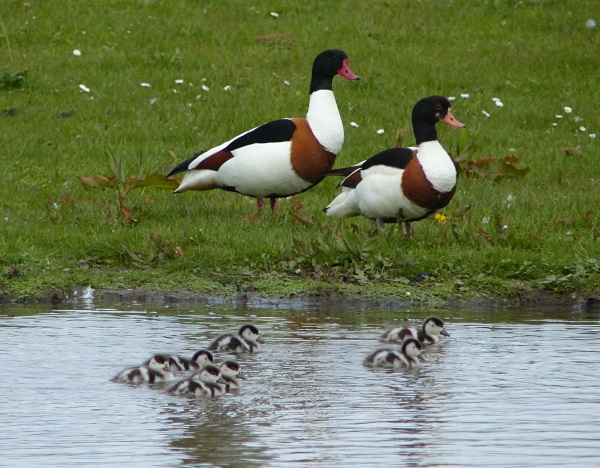
Richard Smith.
What to expect in June
Probably the most noticeable event in the estuary will be the build up of gulls, specially Black-headed, but look out for Mediterranean Gulls among the roosting flocks looking great in their full breeding plumage.
We don't really want gales in the middle of the tern breeding season but if we do get some strong westerlies it can make for some great sea-watching and it was June 22nd 2013 when we had 5,000 Manx Shearwatrs fly past Hilbre - the highest ever count, and we should also see loads of Gannets, skuas, Fulmars etc.
As for rarities - over the past few years we've had some crackers in June including a Little Swift, Golden Oriole, Bee-eater and Blyth Reed Warbler, and we usually get a Red Kite or two and even an Osprey can turn up.
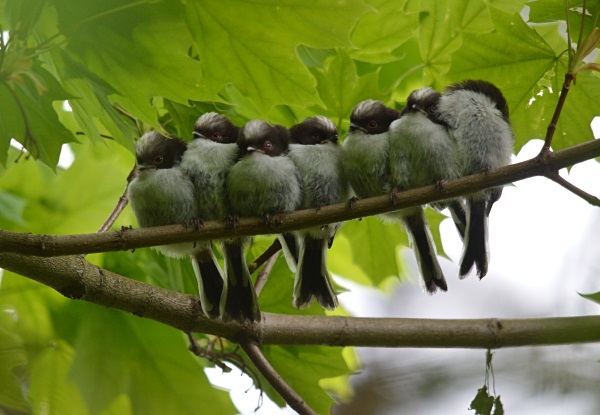
Top of Page
Forthcoming Events
June Highest Spring Tides (Liverpool)
Also
see Tides
page.
16th June, 11.42hrs (BST), 9.1m.
17th June, 12.27hrs (BST), 9.2m.
18th June, 13.09hrs (BST), 9.1m.
Forthcoming Events
Organised by the Wirral
Ranger Service , Flintshire
Countryside Service and the
RSPB (Dee Estuary):
All these events and walks have bird interest, even those not
advertised specifically for birdwatching. No need to book for these
events unless specified - please check below.
Also see 2015 Events Diary.